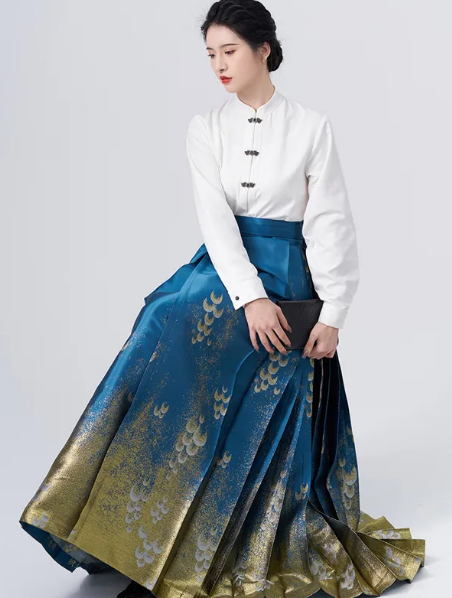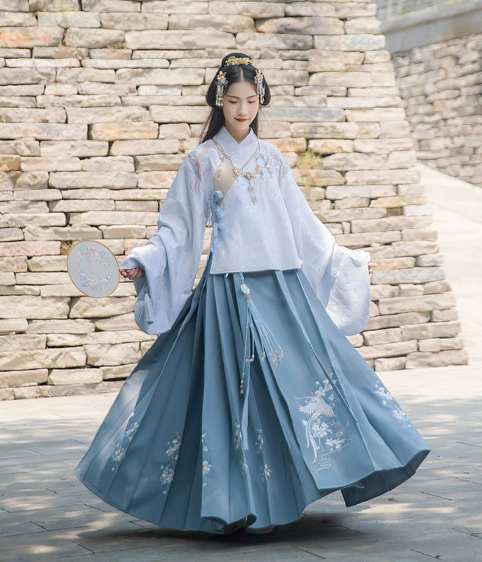Definition and Overview
The Chinese Horse Face Skirt, known as “mamian qun” in Mandarin, is a traditional pleated skirt from the Han Dynasty. The name derives from the skirt’s resemblance to the face of a horse due to its wide and narrow pleats.
Explanation of the Term “Horse Face Skirt”
This skirt features a distinctive pleated structure. Each pleat resembles a horse’s mane, flowing and structured, which provided both aesthetic appeal and functional movement for the wearer.
Historical Context and Origin
The Horse Face Skirt has roots in China’s Han Dynasty (206 BCE – 220 CE). It became prominent due to its use by nobility and the affluent as a status symbol. Artifacts and ancient texts often depict this garment, highlighting its importance in Chinese fashion history.

Design Characteristics
The Chinese Horse Face Skirt showcases a unique structural design that pairs practicality with elegance. Its form-fitting waistband transitions into an A-line shape, characterized by a series of pleats that expand outward, offering a glimpse of the wearer’s grace with every step.
Description of Shape and Cut
The skirt starts with a snug waist and fans out to a wider hem, with pleats that are typically around 30 centimeters deep. This allows for a full range of motion, echoing the traditional need for both beauty and utility in Chinese clothing. The cut often involves multiple layers, with the topmost layer bearing the majority of the pleats.
Traditional Fabrics and Colors
Silk, the most revered fabric in ancient China, was the preferred material for making a Horse Face Skirt, particularly for the upper echelons of society. The colors spanned a wide palette but favored deep reds, symbolizing good fortune, and yellows, a hue reserved for the emperor. The quality of the silk used could vary, with the finest being light, airy, and of a higher thread count, ensuring both the garment’s durability and its status as a luxury item.
For more details on the types of silk used in historical Chinese garments, you might explore the Silk Wikipedia page, which provides information on the material’s quality and significance in Chinese culture.
Cultural Significance
The Horse Face Skirt is not just a piece of clothing but a rich tapestry of Chinese heritage. It encapsulates the values, aesthetics, and social norms of the times it adorned.
Symbolism in Chinese Culture
In Chinese culture, the Horse Face Skirt is more than attire; it’s a canvas of symbolism. The pleats signify wealth and status, while the colors used, such as red and yellow, are deeply tied to luck and imperial authority, respectively. Each skirt tells a story, whether of the person who wore it or the era it represents.
Use in Historical Chinese Fashion
The Horse Face Skirt was a staple in the wardrobe of the Chinese elite, particularly during the Tang Dynasty, an era known for its flamboyant fashion and appreciation for luxurious fabrics. Women of stature paired these skirts with exquisite tunics, indicating their social ranking and adherence to the fashion norms of the period.
For further context on the fashion trends of the Tang Dynasty, one could delve into the Fashion in Tang dynasty Wikipedia page, which offers a detailed look at the sartorial elegance and the parameters that defined one’s style during this golden age of Chinese culture.
Construction Techniques
Crafting a Chinese Horse Face Skirt required mastery in pleating and stitching, techniques that artisans have refined over centuries. The construction of this garment demanded precision, as the symmetry and uniformity of pleats were paramount to its beauty and function.
Ancient Methods of Creation
Artisans meticulously hand-pleated the fabric, often silk, and secured the folds with stitches that were as much about function as they were about decorative art. They used natural dyes to achieve vibrant colors, and the entire process could take several days, depending on the complexity and fineness of the garment.
Comparison with Modern Sewing Practices
Modern sewing techniques have simplified the production of pleated skirts through the use of machines, drastically reducing the time needed from days to mere hours. However, high-end fashion still values hand-pleating for its precision and historical authenticity. Today’s materials vary widely, and while silk remains a premium choice, synthetic fabrics offer a cost-effective and durable alternative.
To understand the evolution of textile production, you can refer to the History of silk Wikipedia page, which provides insight into the transition from ancient handcrafting methods to modern industrial techniques.
Historical Representations
The Horse Face Skirt has graced countless works of art, capturing the essence of historical Chinese fashion and offering a window into the life of ancient China.
Depictions in Chinese Art and Sculpture
Artists have long celebrated the Horse Face Skirt in their work, often painting noblewomen adorned in these elegant garments. Sculptures from various dynasties depict the skirt’s fluid lines and pleats, showcasing the wearers’ status and the skilled craftsmanship of the time. Murals found in ancient tombs, such as those in the Shaanxi Province, include detailed illustrations of the skirt, revealing its significance in aristocratic attire.
References in Classical Chinese Literature
Classical Chinese literature, from poetry to prose, frequently alludes to the Horse Face Skirt, using it as a symbol of feminine beauty and grace. In the renowned work “The Dream of the Red Chamber,” the skirt appears as part of the characters’ wardrobes, indicating their nobility and taste. This literary mention underlines the skirt’s pervasive role in the fashion and culture of the era.
For a more extensive exploration of its literary presence, one could examine the Dream of the Red Chamber Wikipedia page, which might offer further insights into how the Horse Face Skirt is woven into the narrative fabric of one of China’s most celebrated novels.

Modern-Day Legacy
The Horse Face Skirt, with its deep historical roots, has seamlessly transitioned into modern fashion, where it serves as a bridge between the past and present.
Horse Face Skirt in Contemporary Fashion
In today’s fashion landscape, designers frequently draw inspiration from the Horse Face Skirt, skillfully weaving its traditional elements with a modern twist. They often reinterpret the classic pleats, ensuring that the skirts are not only reminiscent of their historical counterparts but also resonate with current trends. This modern iteration typically comes in varying lengths and utilizes both time-honored textiles and new-age materials, thereby broadening its appeal to a contemporary audience.
Preservation Efforts in Chinese Museums
Meanwhile, Chinese museums are diligently working to safeguard these historical garments. By meticulously preserving ancient Horse Face Skirts, they offer a tactile connection to the past. Institutions such as the National Museum of China in Beijing showcase these garments as priceless artifacts, some dating back centuries. These preservation initiatives not only celebrate the garment’s intricate design but also its enduring legacy, ensuring that the artistry behind the Horse Face Skirt is not lost to time.
For a more comprehensive understanding of how these cultural relics are maintained, one could delve into the resources provided on the National Museum of China’s Wikipedia page, which outlines their exhibits and the meticulous care invested in preserving China’s sartorial heritage.